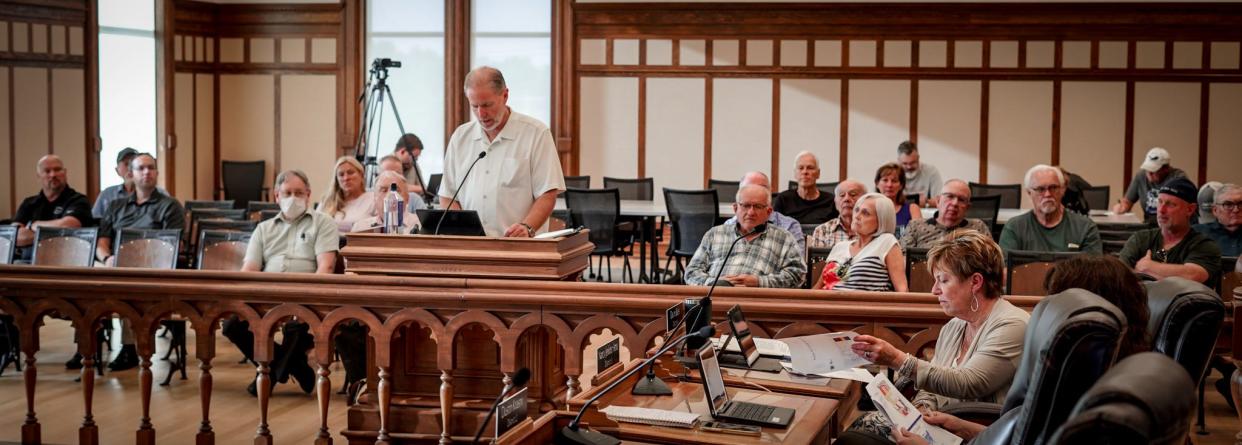Broadband map reveals significant gaps in internet coverage in Lenawee County

ADRIAN — There remain significant gaps in broadband coverage throughout Lenawee County. A county-commissioned mapping study reveals that of 41,753 occupied parcels, 2,701 are unserved.
The broadband mapping report prepared by Chris Scharrer, founder and CEO of DCS Technology Design of Chelsea, did not surprise those present Thursday evening at a special meeting of the Lenawee County Board of Commissioners.
The audience of about 15 people were on hand to find out about the lack of service or sketchy service at their Lenawee County homes. Some spoke of not being able to do their jobs because of a lack of internet service. To get coverage at their homes through a provider, many would have to pay tens of thousands of dollars.
The $75,000 study was paid for with American Rescue Plan Act funds. Scharrer provided the most up-to-date map of internet coverage relying on data released by local internet service providers (ISP) rather than dated information from the Federal Communications Commission (FCC).
To view the interactive map, visit tinyurl.com/LenCoBroadbandMap. Residents can click on the magnifying glass icon search function and enter their address to show what type of internet coverage is available in their area. For the key to reading the map, visit tinyurl.com/LCBroadbandSurvey.
Scharrer said that funding will soon become available through the federal Broadband Equity Access and Deployment (BEAD) program. BEAD will provide $42.45 billion to expand high-speed internet access by funding planning, infrastructure deployment and adoption programs. Eligible entities will receive initial funds to support broadband planning and related capacity efforts such as mapping, staffing state/territory broadband offices, outreach and coordination with local communities.
Subscribe Now: For all the latest local developments, breaking news, and high school and college sports content.
The remaining funding will be allocated based on a formula that considers the number of unserved and high-cost locations in the state. The first priority will be to provide broadband to unserved areas or those below 25/3 megabits per second (Mbps) in download/upload speeds.
Mbps are units of measurement for network bandwidth and throughput. They are used to show how fast a network or internet connection is. Each Mbps represents the capacity to transfer 1 million bits each second, or roughly one small photo per second.
The second priority will be underserved areas (those below 100/20 Mbps), and then serving community anchor institutions at 1/1 Gigabit per second (Gbps). Gbps is a unit of data transfer rate equal to 1,000 Mbps.
Those receiving gigabit speeds are capable of sending or receiving data at 1 billion bits per second. The lowest speed that is considered broadband is 25 Mbps, and 1 Gbps is 40 times faster than that.
There are nine ISPs in Lenawee County providing a mixture of hybrid fiber-coaxial (HFC) and fiber to the home (FTTH).
HFC is a broadband telecommunications network that combines optical fiber and coaxial cable. It has been commonly employed globally by cable television operators since the early 1990s.
HFC and FTTH networks differ in that HFC extends fiber to a node within a mile of the home or business, while FTTH extends fiber all the way to the home or business — typically terminating the fiber at a customer premises device, which then provides service to devices in the home over copper lines, coaxial cable, or wireless connections.
Three Lenawee County ISPs offer HFC, while one offers a combination of HFC and FTTH and the remaining five offer FTTH. The goal is to work with local ISPs to get FTTH coverage throughout the county, a technology that should be the dominant type for the next 20-30 years, Scharrer said.
Approximately $17.5 million to $21.6 million is needed to assure reliable internet access in the county, Scharrer said. He estimates that actual work installing fiber to unserved and underserved areas would begin in early 2025.
The next steps in the process will include coordination with local ISPs and securing the BEAD funding. County administrator Kim Murphy said that she spoke to Scharrer prior to the meeting about a possible expansion of his project scope to assist the county with next steps. A timeline for those discussions has not been set.
With the passage of the Infrastructure Investment and Jobs Act (IIJA) of 2021, Congress set a goal of providing broadband access to the entire country. The IIJA set forth a $65 billion investment into broadband.
Unserved and underserved residents are urged to call the county administrator's office at 517-264-4508 and their local municipalities to make officials aware of problems with broadband coverage to assist efforts in securing funding.
This article originally appeared on The Daily Telegram: Broadband map reveals significant gaps in coverage in Lenawee County

